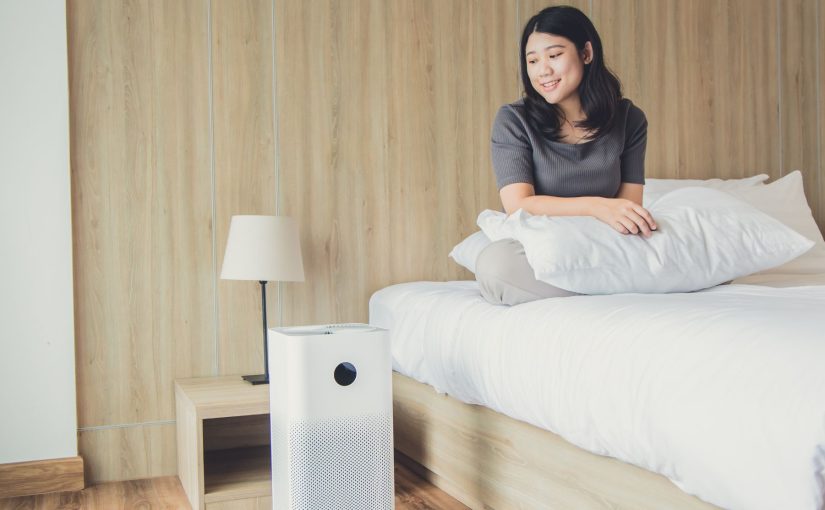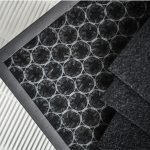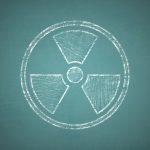An In-Depth Guide to the Different Types of Air Purifiers
Table of Contents
I. Introduction
Indoor air quality has become an increasing concern in recent years. The EPA estimates that indoor air is 2 to 5 times more polluted than outdoor air. Poor indoor air quality can lead to various health issues like allergies, asthma, and chemical sensitivities.
Air purifiers provide an effective solution for cleaning the air inside your home. They work by filtering out pollutants like dust, pollen, mold, bacteria, pet dander, smoke, VOCs (volatile organic compounds), and more.
There are several different technologies used in air purifiers:
- HEPA (High Efficiency Particulate Air) filters – Most common type of air purifier filter, can capture 99.97% of particles 0.3 microns in size.
- Activated carbon filters – Absorb gases, odors, smoke, VOCs, and chemicals.
- UV-C light – Uses ultraviolet light to kill germs like bacteria and viruses.
- Ionic filters – Generate negative ions to attract and trap pollutant particles.
- Ozone generators – Produce ozone gas to oxidize and destroy contaminants.
This guide provides an in-depth look at how each type of air purifier works, their pros and cons, and popular options available.
| Type | Pros | Cons |
|---|---|---|
| HEPA | Removes 99.97% of particles; great for allergies | No gas/odor removal; filter needs replacing |
| Activated Carbon | Eliminates odors and gases | Doesn’t capture particles; filter needs replacing |
| UV-C | Kills mold, bacteria, viruses | Doesn’t remove particles or gases |
| Ionic | Inexpensive; no filter replacing | Limited particle removal; potential ozone |
| Ozone Generator | Not recommended due to health risks |
II. HEPA Air Purifiers
What is a HEPA Filter?
HEPA stands for High Efficiency Particulate Air. HEPA filters are designed to remove tiny particles from the air that can be harmful to breathe.
Particles that are 0.3 microns or larger are trapped with 99.97% efficiency. For reference, a human hair is about 100 microns wide. Common indoor air pollutants in this size range include:
- Dust
- Pollen
- Pet dander
- Mold spores
- Bacteria
- Smoke particles
- PM2.5 particulate matter
HEPA filters utilize a dense mesh of randomly arranged fiberglass fibers. As air passes through, particles are captured and retained in the filter. This removes them from the circulating air.
Pros of HEPA Air Purifiers
- Proven effectiveness – Extensively tested to meet strict performance standards. Government agencies like the Department of Energy rely on HEPA filtration.
- Removes most common allergens – HEPA is excellent at trapping dust, pollen, pet dander, mold spores and other particulate allergens. This helps reduce allergy and asthma symptoms.
- No byproducts or emissions – HEPA filters simply capture contaminants without producing any ozone or other chemicals. They don’t generate any secondary pollution.
Cons of HEPA Air Purifiers
- Doesn’t remove odors or gases – HEPA filters cannot absorb VOCs, smoke smells, chemical fumes and other gaseous pollutants. Need added activated carbon filter for this.
- Can be noisy – The fans required to pull air through dense HEPA filters can generate noise levels of 50 dB or more on higher speed settings.
- Replacement filters are required – HEPA filters become clogged after 6-12 months depending on use. Replacement filters can cost $50 to over $100.
- Larger particles first – HEPA is least efficient at capturing the smallest particles between 0.1 – 0.3 microns. Larger particles tend to clog the filter first.

 Popular HEPA Air Purifier Models
Popular HEPA Air Purifier Models
- Winix 5500-2 – This is a leading air purifier for allergy and asthma sufferers. It includes true HEPA filtration, washable pre-filters, and activated carbon for odors.
- Coway AP-1512HH Mighty – A top rated HEPA air purifier known for quiet operation and energy efficiency. Has built-in air quality sensor and auto mode.
- Blueair Classic 480i – Boasts a combination HEPA and activated carbon filter, WiFi connectivity and can cover large rooms up to 600 sq. ft.
- Austin Air HealthMate HM400 – A robust unit built for extra large rooms and sensitive individuals. Has medical grade HEPA filter and 15 lbs. of activated carbon.
- IQAir HealthPro Plus – A state-of-the-art air purifier used in hospitals and medical settings. Equipped with HyperHEPA filters that are 99.5% efficient on particles down to 0.003 microns.
 III. Activated Carbon Air Purifiers
III. Activated Carbon Air Purifiers
What is Activated Carbon?
Activated carbon is a highly porous material made from carbon. It has an incredibly large surface area that allows it to absorb and trap gases, chemicals and odors.
The “activation” process expands the pores and increases the surface area dramatically, creating an adsorbent material. Activated carbon is used in water filters, automotive cabin air filters, and of course, air purifiers.
In air purifiers, a layer of activated carbon is added to filtration systems. As air passes over the carbon, the pores capture VOC gases, cigarette smoke, cooking odors, pet odors, paint fumes, and other airborne chemicals.
Activated carbon removes these gaseous pollutants that standard HEPA filters cannot. The carbon also helps neutralize odors by adsorbing the molecules that cause smelly air.
Pros of Activated Carbon Air Purifiers
- Eliminates odors – Excellent at removing cooking smells, pet odors, cigar and cigarette smoke, musty smells and other odors from the air.
- Absorbs gases & VOCs – Takes out fumes from adhesives, paints, pesticides, cleaners and other chemical sources. Reduces indoor air pollution.
- Quiet operation – Activated carbon filters have low air resistance so fans don’t need to work as hard. Units run more quietly as a result.
- Often combined with HEPA – Many air purifiers combine HEPA filtration with activated carbon. This gives you the best of both worlds.
Cons of Activated Carbon Air Purifiers
- Doesn’t remove particles – Activated carbon only filters gases and odors. To remove dust, dander, etc. it needs to be paired with a HEPA filter.
- ** eventual replacement** – The carbon’s absorption sites get filled over time and it stops working. Replacement filters needed every 6-12 months.
- Not effective for some VOCs – Doesn’t work well for formaldehyde and other small molecular VOCs. Significant sources may require dedicated gas absorber filter.
- Can release trapped odors – Gas molecules trapped in the carbon can escape back into the air later. Periodic regeneration is required.

 Popular Activated Carbon Air Purifier Models
Popular Activated Carbon Air Purifier Models
- Austin Air Healthmate Standard – A simple yet high performing unit focused on activated carbon filtration. Includes 15 lbs. of carbon and HEPA filter.
- IQAir GC MultiGas – Commercial grade system designed for chemical sensitivity and VOC removal. Has 9 lbs. of activated carbon and HyperHEPA filtration.
- Blueair Classic 480i – Combines activated carbon and HEPA filtration. Has auto mode, WiFi control and large room capacity.
- Winix 5500-2 – This popular model includes activated carbon pellets to reduce odors along with true HEPA particle filtration.
- Honeywell HPA300 – An affordable room air purifier with a washable carbon pre-filter and HEPA filter for reduced operating costs.
IV. UV-C Air Purifiers
How Does UV-C Technology Work?
UV-C air purifiers use short-wavelength ultraviolet light to kill or deactivate microorganisms like bacteria, viruses, and mold.
UV-C radiation damages the DNA and RNA of these organisms, rendering them unable to reproduce or function. This creates a germicidal effect without the use of chemical biocides.
Air purifiers emit UV-C light into an internal chamber that the airflow passes through. This exposure kills mold spores, bacteria, viruses and other biological contaminants in the air.
Some UV-C systems also utilize titanium dioxide filters that are activated by the UV light. This catalyzes oxidation reactions that destroy VOCs and odors.
Pros of UV-C Air Purifiers
- Attacks biological pollutants – UV light has been proven effective at neutralizing mold, bacteria, viruses, and other living microbiological contaminants.
- No filter changes required – Since UV-C works by irradiation rather than filtration, there are no filters to replace. Reduces operating costs.
- Chemical free purification – UV purification is achieved without using ozone or other potentially hazardous chemicals.
- Odor reduction capability – Units with TiO2 filters also help remove VOCs and smoke odors as air passes through the UV chamber.
Cons of UV-C Air Purifiers
- Doesn’t remove particulate matter – UV light has no effect on dust, pollen, pet dander and other non-living particles. HEPA filter still needed for these.
- Exposure risks – Direct UV exposure can damage skin and eyes. The irradiation chambers must be shielded to prevent UV rays leaking out. Cheaper units may have inadequate shields.
- Limited air flow – The irradiation chamber and shields restrict airflow, reducing CADR ratings compared to HEPA-only air purifiers. Not suitable for large spaces.
- Bulb replacement – UV-C bulbs lose intensity over time and need replacement every 2-3 years to maintain effectiveness.

 Popular UV-C Air Purifier Models
Popular UV-C Air Purifier Models
- Alen BreatheSmart Flex – A customizable unit with HEPA-FreshPlus filter and UV-C sanitization chamber with 10 UV bulbs.
- **Geniani Aircare – **Combines a True HEPA filter with UV-C light chamber containing 3 UV bulbs to kill germs.
- Guardian Air 5-in-1 – Features UV-C technology along with HEPA and activated carbon filters for complete air purification.
- Heaven Fresh HF 780 – This air purifier includes UV-C light, nano-photocatalyst filter and 5-stage HEPA filtration for whole home use.
- Envion Therapure TPP240 – Compact UV tower unit good for smaller rooms. Has UV-C, HEPA filter, and optional ionizer.
V. Ionic Air Purifiers
How Do Ionic Air Purifiers Work?
Ionic air purifiers work by charging air molecules and pollutants with electrons using an electrostatic charge field. This generates positive and negative ions that are released into the passing air stream.
The extra electrons attach to particles like dust, dander, pollen, mold and cigarette smoke. This gives them a negative charge so they are attracted to the positively charged collection plates inside the air purifier.
This electrostatic process causes the charged particles to clump together and become large enough to be captured on the plates. Some ions exit the unit to attach to out-of-reach particles as well.
Pros of Ionic Air Purifiers
- Inexpensive – Ionic purifiers are one of the most budget-friendly options since they don’t require expensive HEPA filters. Lower operating costs.
- Silent operation – With no fans or mechanical filters, most ionic purifiers run completely silently.
- Ozone free – Many ionizers now use needlepoint ion generation which does not produce dangerous ozone gas as a byproduct. Look for “ozone free” models.
- No maintenance – Ionic filters don’t need replacement like HEPA filters. Just occasional cleaning of collection plates.
Cons of Ionic Air Purifiers
- Limited particle removal – Ionic purifiers only remove about 30% of larger particles and 10% of fine particles. Not effective enough to be a sole air cleaner for many situations.
- Dirty plates – Collection plates become coated with particles and need frequent cleaning to remain effective. Plates may need weekly cleaning.
- Potential ozone production – Poor quality ionizers, especially older ones using corona discharge, can generate hazardous levels of lung-damaging ozone.
- Charged particle emissions – Some negatively charged particles may get re-released into the room air instead of being collected. There are health concerns over effects of inhaling charged particles.

 Popular Ionic Air Purifier Models
Popular Ionic Air Purifier Models
- Winix Plasmawave 5300 – A newer unit that uses ozone-safe needlepoint plasmawave ion generation combined with basic carbon filtration.
- Oion Technologies B-1000 – Compact ozone-free ionizer good for travel. Uses radio-frequency transmitted ions to charge particles.
- Pure Enrichment PureZone – Budget ionizer and HEPA filter combination unit. Plates need frequent cleaning.
- Envion IonAir – Retro-looking ionizer tower designed for smaller rooms. Has 3 fan speed settings and optional UV-C.
- Sharper Image Ionic Pro – Oscillating compact ionic air purifier with touch controls and PM2.5 particle sensor.
VI. Ozone Air Purifiers
What is Ozone and How Do Ozone Generators Work?
Ozone is an unstable toxic gas made up of three oxygen atoms (O3). While ozone exists naturally in the upper atmosphere, at ground level it is classified as an air pollutant.
Ozone generators produce ozone artificially using corona discharge or UV light methods. The strong oxidizing power of the O3 molecules destroys bacteria and odors. But it also damages lung tissue lining when inhaled.
Most health organizations recommend avoiding ozone generators since potential harms outweigh benefits. Ozone does not effectively clean and purge indoor spaces of pollutants either, as was once believed.
Pros of Ozone Air Purifiers
- Attacks odors – The oxidizing potential of ozone may have some effectiveness at removing stubborn odors that linger even after cleaning.
- Inexpensive – Basic ozone generators are cheap since they have no filters and few parts.
Cons of Ozone Air Purifiers
- Health hazards – Multiple studies have shown health risks of ozone, especially for children and those with asthma or respiratory conditions. Short term effects include chest pains, coughing, throat irritation and lung damage.
- No particulate filtration – Ozone does not remove dust, pollen, pet dander, mold and other common airborne particles.
- Ineffective pollution removal – Ozone has low reactivity with many chemicals like VOC gases. It does not cleanse rooms of pollutants as marketed.
- Property damage potential – Ozone can degrade rubber, plastic and fabrics, causing damage to belongings. Many materials are not ozone resistant.
Examples of Ozone Generator Air Purifiers
- Ozone generators are not commonly found anymore due to health concerns, but a few models still exist:
- EcoQuest Fresh Air – Uses coronal discharge to produce ozone. EcoQuest claims their “activated oxygen” process is safe but many health agencies disagree.
- OdorStop OS2500 – An industrial style ozone generator that creates very high ozone concentrations advertised to remove smoke odor. Too high for safe residential use.
- Airthereal MA10K-PRO – Despite marketing as an ionizer, it uses UV bulbs to generate ozone rather than the safer needlepoint method.
- Ecozone Ozone Generator – Among the most affordable ozone machines but puts out an alarming amount of ozone at up to 7,000 mg/hr.
VII. Conclusion
There are a variety of air purifier technologies available to improve indoor air quality:
- HEPA air purifiers are the most effective at removing airborne particles like dust, dander and allergens.
- Activated carbon air purifiers excel at adsorbing odors, gases and VOCs that HEPA filters miss.
- UV-C air purifiers use germicidal ultraviolet light to destroy mold, bacteria and viruses.
- Ionic air purifiers charge and attract particles to collection plates though not as efficiently as HEPA.
- Ozone generators are not recommended for air purification due to health risks.
When selecting an air purifier, HEPA and activated carbon models offer the best overall indoor air cleaning. Try to get a unit sized appropriately for the room it will be used in. Compare CADR ratings and noise levels between different makes and models to find one that fits your needs and budget.
With good quality HEPA and carbon filtration, you can successfully remove dust, allergens, odors, smoke, pet dander, VOCs and more for healthier indoor air.
Here is a 9 question frequently asked questions section to add to the air purifier article:
Frequently Asked Questions
Q: How often should you replace air purifier filters?
A: For HEPA and carbon filters, replacement is typically needed every 6-12 months depending on use. Ionic filters may only need cleaning every few months. UV bulbs need replacement every 2-3 years.
Q: Where is the best place to put an air purifier?
Air Purifier Filter Replacement Frequency
| Filter Type | Typical Replacement Frequency |
|---|---|
| HEPA | Every 6-12 months |
| Activated Carbon | Every 6-12 months |
| UV Bulb | Every 2-3 years |
| Ionic Collection Plates | Cleaning every few months |
: Place air purifiers in high traffic areas and bedrooms. Avoid corners or tight spaces that obstruct airflow. Elevate purifiers if possible to better circulate air.
Q: Do air purifiers use a lot of electricity?
A: Air purifiers use anywhere from 50 watts on low speeds up to 500 watts on turbo modes. Running costs are generally $3 to $10 per month. Look for Energy Star rated models for efficiency.
Q: Can air purifiers reduce COVID virus?
A: HEPA filters can reduce coronavirus aerosols. UV-C bulbs also inactivate viruses. But air purifiers alone cannot remove all infection risks. Vaccination, masks and ventilation are still important.
Q: How do I know if my air purifier is working?
A: Many air purifiers have air quality sensors that display real-time readings of particulate and VOC levels. Visually inspecting filters for trapped particles also verifies they are working.
Q: Do air purifiers with ionizers produce ozone?
A: Ionizers that use needlepoint or pinpoint ion generation will not produce hazardous ozone. Avoid older corona discharge ionizers.
Q: Can air purifiers help with asthma?
A: Yes, by reducing airborne asthma triggers like dust, pollen, mold and pet dander, air purifiers can greatly benefit asthma sufferers.
Q: Are cheap air purifiers effective?
A: Very inexpensive ionic-only air purifiers often don’t perform well enough to be a primary air cleaner. Invest in a quality HEPA air purifier for best results.
Q: How large an area can air purifiers cover?
A: Air purifier effectiveness depends on CADR rating and room size. A higher CADR can cover larger spaces. Most models are made for individual rooms up to 500 square feet.
-
- Environmental Protection Agency (EPA) – The EPA has resources on indoor air quality and regulating air purifiers: https://www.epa.gov/indoor-air-quality-iaq












